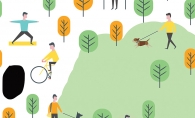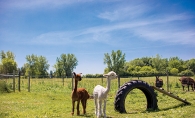Through a window overlooking Wildwood Elementary’s outdoor play area, principal Mark Hamre reveals the spots where the kids play at recess. There is a hard surface area, pavement where kids play basketball and foursquare. There is a traditional playground, a structure brought over from the old elementary school. And there is the natural playground, a concept embraced by the community and a point of pride for the school.
Opened in 2013, the new Wildwood Elementary School serves students in preschool through second grade. With a separate preschool playground next door, come recess time, many kids are eager to venture outdoors to stretch their legs and imaginations. At any given recess time, 80 to 110 students will be outside utilizing all of the school’s play options, including its natural play area.
The school’s natural playground uses natural elements—grass, stone, sand and trees—to create play experiences. The playground begins with the main structure: a grass-covered hill with a large surface area for kids to traverse. Six to 8 feet high, the hill is graduated and has features built into its sides, including a slide, a climbing wall, a stone cave, a natural amphitheater and a sandbox area. The playground is surrounded by a green field, which is enclosed by a walking trail. The playground committee, which was started by Hamre and consists of teachers, parents and community members, introduced the idea for the playground in 2011, two years before the school opened. The idea of a natural play experience resonated with the members because it connected back to their favorite memories of playing outside as kids. After agreeing to the idea, the committee hired and collaborated with a company—Natural Playgrounds—to design the outdoor area.
“What became very surprising to us was the community support,” Hamre says. Costing over $200,000, the project was funded through the donations from local organizations and individuals. The major donors, whose names are inscribed on the playground’s official sign, are Mahtomedi Area Green Initiative (MAGI), Jim and Marlene McKeown, Mahtomedi Public School District, Hanifl Foundation, Mahtomedi Area Education Foundation, Wildwood/OH Anderson PTO and the playground committee members.
Because the project was such a huge endeavor, it needed to be completed in stages. Phase 1, completed two summers ago, included installing the natural play area for the preschool and the elementary playground’s foundation: the hills, the climbing structures, the slides and the trees. Many of the trees were funded through a MAGI fundraiser, which allowed families to purchase trees in honor of or in memory of someone. Families were additionally invited to the school’s tree planting ceremony. Phase 2, completed last summer, included planting more trees and installing the walking trail.
“One of the things we were hoping to do is create opportunities for creative play,” Hamre says of one of the playground’s benefits. And it definitely has. Hamre has seen kids play inside the cave, pretending it is an igloo; he has watched them bring sticks inside the cave, making a pretend campfire. The kids will play on logs, play games in the field, and run up and down the hills. Students also love to make things in the sandbox. Hamre polled some of his students about what they like most about the natural playground, and answers ranged from the sandbox to the climbing wall to the wide-open field.
The natural playground is well-loved by the kids at the school, a fact made clear by the worn spots on the hill where kids play. Community members use it during off-school hours, too; local residents bring their kids to the playground on evenings and weekends. “It’s been a wonderful addition to our school,” Hamre says. “We have a beautiful setting for it. It really seems to resonate with a lot of people.”









